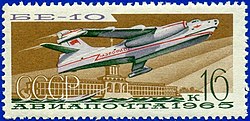Beriev Be-10
| Beriev Be-10 | |
|---|---|
 Be-10 on a Soviet postage stamp (1965) |
|
| Type: | Flying boat |
| Design country: | |
| Manufacturer: | |
| First flight: |
June 20, 1956 |
| Number of pieces: |
27 + prototype (s) |
The Berijew Be-10 ( Russian Бериев Бе-10 , NATO code Mallow , German Malve ) is a flying boat made by the Soviet manufacturer Beriev . The machine is a further development of the Beriev R-1 . The primary purpose was maritime reconnaissance and ship combat. The first flight took place on June 20, 1956.
development
The all-metal shoulder- wing wing wing is powered by two jet engines, which are arranged on both sides of the fuselage under the wing root. Support floats are mounted at the ends of the wings, which have a pronounced negative V-position. The wings themselves are swept at 50 ° and each has two boundary layer fences . In order to minimize the risk of water being sucked into the engines, there are spray deflectors on the front part of the fuselage. The hull has one step and a small rudder in the stern for maneuvering on the water.
The flight tests of the machine with a total of 76 flights lasted until October 20, 1958. The original design showed some weaknesses in seaworthiness and had to be modified. The modified version was able to take off and land on the water up to a wave height of 1.2 m at a wind speed of up to 16 m / s. A small series production was then started, in which 27 machines were manufactured. But these machines also proved difficult to fly and there were several accidents. The type was presented to the public for the first time at the aviation parade on July 9, 1961 in Tuschino. Because of the better range performance of the Beriev Be-12 , however, this was ultimately given preference. On August 7, 1961, a machine of the type with the crew of Nikolai Andrijewski reached a new world speed record in its class with 912.00 km / h. In addition to four other speed-payload records, a three-man crew under Georgi Burjanow also flew seven summit height world records with and without a payload from September 3 to 12, 1961, the highest altitude of which was 14,962 m. Most of these records still exist today. The machines were shut down in 1968 because of problems with strength.
The armament consisted of two cannons in a radar-controlled stern turret and two further cannons that were rigidly built into the nose of the fuselage. Anti-submarine weapons were provided as an external load as drop armament.
Technical specifications
| Parameter | Data |
|---|---|
| crew | 3 |
| span | 22.30 m |
| length | 31.10 m |
| Wing area | 111.8 m² |
| Top speed | 911 km / h |
| Cruising speed | 800 km / h |
| absolute summit height | 14,962 m |
| Service ceiling | 12,500 m |
| Range | 4,800 km |
| Range with full load | 2,100 km |
| Empty mass | 24,100 kg |
| Takeoff mass | Max. 46,500 kg |
| drive | two jet engines Ljulka AL-7 PB each with 63.8 kN thrust |
| Armament | four 23 mm NS-23 cannons and 2000 kg drop armament |
Web links
- Photos 1946–1967. Beriev Aircraft Company, accessed December 31, 2014 (English, brief description of the Be-10 with photo).
Individual evidence
- ^ Karl-Heinz Eyermann , Wolfgang Sellenthin: The military aviation of the USSR. Central Board of the Society for German-Soviet Friendship, 1967, p. 42.